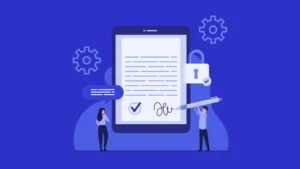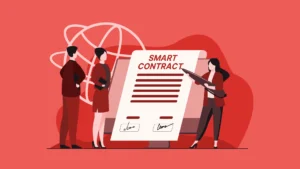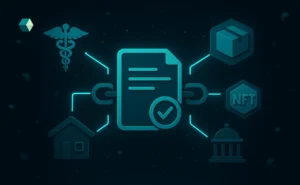
At the core of every society lies one powerful element, trust.
From ancient trade routes to today’s digital world, people have always made agreements built on promises like, “You give me this, I’ll give you that.” These simple exchanges have shaped relationships, businesses, and even civilizations.
But as the world went online, that face-to-face trust started to fade. Deals turned into data, and promises traveled through digital networks instead of handshakes.
That’s when a revolutionary idea changed everything — smart contracts.
They’re not paper documents or legal jargon, but self-executing codes that automatically carry out agreements without needing a middleman.
To understand how this innovation began, we need to go back, before Bitcoin and blockchain, to the vision of a man who imagined a world where trust could be built into technology itself.
The History of Smart Contracts
Before anyone had even heard the word “blockchain,” Nick Szabo, a computer scientist, legal scholar, and cryptographer, was imagining a future that merged technology and law. In the early 1990s, Szabo coined the term “smart contract.”
He defined it as:
“A computerized transaction protocol that executes the terms of a contract.”
At a time when most people were still using dial-up internet, Szabo was thinking decades ahead. He saw how physical contracts depended on trust — lawyers, banks, brokers — and wondered if computers could automate that trust through code.
To explain his idea, he used a vending machine analogy.
When you put money into a vending machine, the machine automatically gives you a product. There’s no human overseeing the deal; the rules are already programmed. If you don’t insert enough coins, you get nothing. Simple, transparent, and fair.
Szabo envisioned this logic applied to digital transactions. Imagine a car rental contract where, once you send payment, a digital key automatically unlocks your rented vehicle — no paperwork, no intermediaries.
This concept was revolutionary, yet there was a catch. The internet back then wasn’t decentralized. There was no tamper-proof ledger to store or enforce these contracts securely. Szabo had the vision, but the world lacked the infrastructure to make it real.
He didn’t stop there, though. In 1998, he proposed “Bit Gold,” a digital currency idea that predated Bitcoin by more than a decade. Bit Gold incorporated many ideas that would later define blockchain: proof of work, decentralization, and digital scarcity.
Szabo’s theories planted the first seeds of what would become the modern crypto landscape, not just in finance, but in how society defines trust without intermediaries.
To explore this evolution further, you can read the evolution of smart contracts in blockchain; it perfectly captures how Szabo’s early writings became the backbone of decentralized systems we use today.
The Missing Link – Pre-Blockchain Digital Currency Experiments
The 1990s and early 2000s were buzzing with digital currency experiments. Cryptographers and programmers were trying to create money for the internet age. Projects like eCash, Hashcash, and b-money introduced digital tokens and privacy concepts, but none could solve the trust problem — how to ensure that no one could double-spend or manipulate transactions.
Nick Szabo’s Bit Gold was close but not fully decentralized. It lacked a shared ledger to verify who owned what. Without a common, secure database, the dream of smart contracts remained an idea on paper.
Still, these experiments laid the foundation. They gave future innovators the building blocks — cryptography, consensus, and peer-to-peer systems — that would soon combine into a single, powerful creation: Bitcoin.
The Bitcoin Revolution – Trust in Code Begins
In 2008, under the pseudonym Satoshi Nakamoto, an unknown figure (or group) released the Bitcoin whitepaper:
“Bitcoin: A Peer-to-Peer Electronic Cash System.”
For the first time, the world saw a fully decentralized digital currency. No banks, no middlemen, just code, cryptography, and math. Bitcoin introduced a blockchain, a distributed ledger that recorded every transaction transparently and immutably.
It was trust, not in humans, but in mathematics.
Although Bitcoin was a technological marvel, it was limited. It could transfer value but couldn’t execute complex agreements. If Alice wanted to send Bob money only after a specific event occurred, Bitcoin couldn’t handle that logic natively.
This limitation left an open question: could we build a blockchain that not only records transactions but executes logic?
A system where code itself acts as the law?
That question would soon find its answer in the form of Ethereum.
Ethereum – Turning Szabo’s Dream Into Reality
In 2013, a 19-year-old programmer named Vitalik Buterin envisioned something revolutionary. He admired Bitcoin’s decentralized nature but saw that its scripting language was too limited for more advanced applications. His idea was simple yet profound: a general-purpose blockchain where anyone could program decentralized applications.
He called it Ethereum.
In his whitepaper, Buterin described Ethereum as a “world computer,” a platform capable of executing smart contracts that automatically perform actions when certain conditions are met.
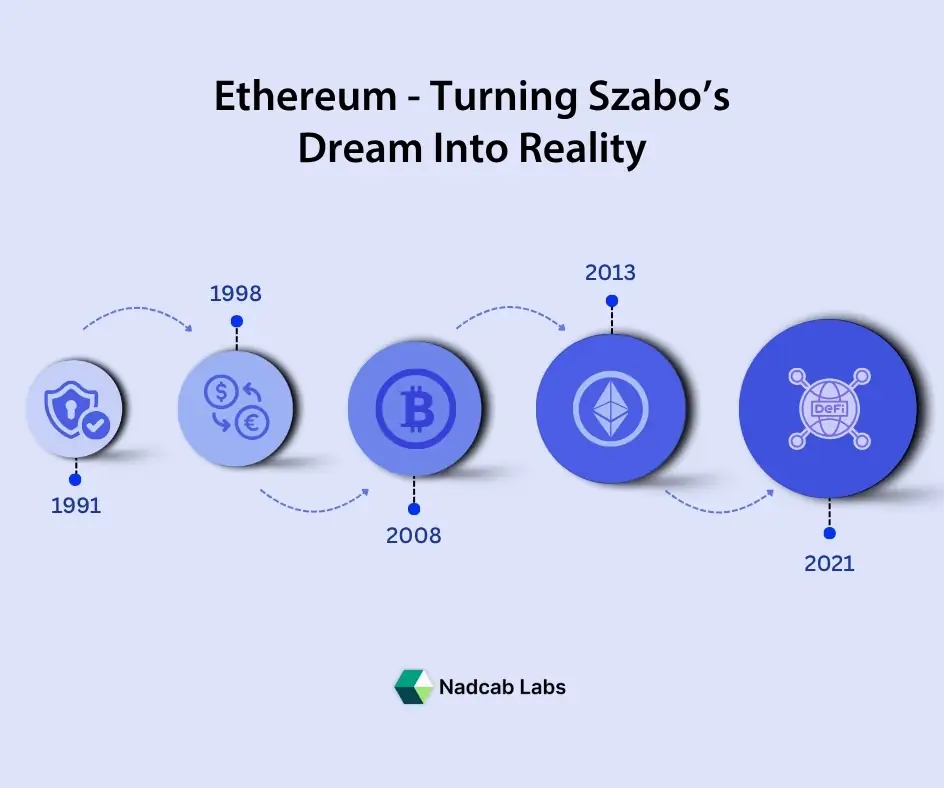
Imagine a world where:
- A loan automatically repays itself through on-chain data.
- A digital identity system verifies users without passwords.
- A game runs entirely on blockchain, where players own their in-game assets permanently.
Ethereum made all of this possible. It introduced Solidity, a programming language that allowed developers to write contracts like:
if condition is met → execute function.
In essence, code became law.
Ethereum’s Ethereum Virtual Machine (EVM) allowed every node in the network to execute the same code, ensuring transparency and consensus. If a smart contract said, “Send 10 ETH when X happens,” the entire network verified and enforced it, without bias, error, or manipulation.
This was the birth of Web3, a decentralized internet where power shifts from corporations to individuals.
To learn more about Ethereum’s origins, check out a short history of Ethereum, which details how Buterin and his team transformed the concept of smart contracts into the foundation of modern decentralized ecosystems.
The ICO Boom – Smart Contracts Go Mainstream
When Ethereum launched in 2015, it didn’t take long for developers and entrepreneurs to realize its potential. By 2017, the world witnessed an explosion of Initial Coin Offerings (ICOs), a fundraising mechanism powered entirely by smart contracts.
Projects could now issue tokens, collect funds, and distribute ownership automatically through blockchain code.
It was the democratization of investment: anyone, anywhere, could participate in funding innovation.
However, this newfound freedom also brought chaos. Many ICOs turned out to be scams or poorly executed ideas. The lack of regulation led to a wave of failures, reminding the world that while code is powerful, it still needs human oversight and integrity.
But through the turbulence, the foundation was set. Smart contracts had proven their potential to disrupt entire industries.
[Also Read: Launch Successful ICO in 2025]
Decentralized Finance – The Age of Automation
From 2018 onwards, the blockchain world shifted its focus from fundraising to functionality. Developers began using smart contracts to replicate traditional financial systems but without intermediaries.
This was the dawn of DeFi (Decentralized Finance).
Protocols like Uniswap, Aave, and Compound allowed users to trade, lend, and earn interest directly through smart contracts. There were no banks, no middlemen, just users and transparent code.
In DeFi, every transaction is traceable, every rule is visible, and every outcome is verifiable.
The power once concentrated in centralized institutions now lay in the hands of the global community.
Smart contracts weren’t just automating finance; they were redefining fairness.
NFTs and DAOs – Expanding the Purpose of Smart Contracts
Then came the next revolution: Non-Fungible Tokens (NFTs) and Decentralized Autonomous Organizations (DAOs).
NFTs allowed creators to tokenize art, music, and collectibles. Smart contracts ensured creators received automatic royalties every time their work was resold. Suddenly, artists had control over their creations again, something traditional systems had long denied them.
DAOs, on the other hand, reimagined how organizations function. They replaced hierarchy with community voting, powered by smart contracts that automatically executed governance decisions.
In both cases, trust shifted from people to protocol.
Create Your Smart Contract with Ease!
Have an idea in mind? We’ll help you turn it into a secure, transparent, and ready-to-launch smart contract. Simple process, real results — let’s begin!
Beyond Ethereum – The Expanding Universe of Smart Contracts
Ethereum may have been the pioneer, but it wasn’t the final destination. New-generation blockchains like Solana, Cardano, Polkadot, and Avalanche emerged, each improving scalability, transaction speed, and cost efficiency.
Meanwhile, academic research continues to refine how smart contracts are built, verified, and secured. According to Frontiers in Blockchain Research, scientists are exploring ways to make smart contracts safer, more interoperable, and even integrated with artificial intelligence.
This combination of innovation and research ensures that smart contracts aren’t just tools of the present; they’re the infrastructure of our digital future.
The Next Challenge for Smart Tech
While the potential is massive, challenges remain:
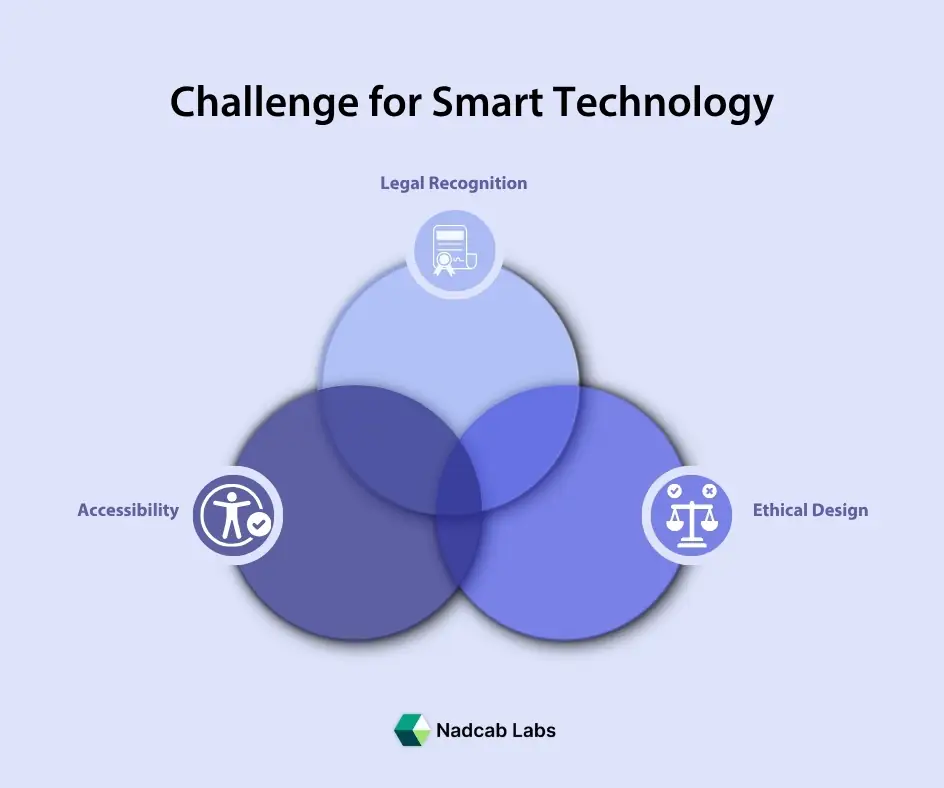
- Legal recognition: How do we enforce or dispute an automated contract in court?
- Accessibility: Many users still struggle with wallets, gas fees, and interfaces.
- Ethical design: Who is responsible when code fails?
Addressing these requires a balanced blend of technology, law, and empathy. The goal isn’t just automation, but fair automation — where every user, regardless of background, can participate confidently.
[Also Read: The Ultimate Guide to Applications of Smart Contracts in Various Sectors]
The Future – Smart Contracts and the AI Connection
Looking ahead, smart contracts may become more intelligent and adaptive, merging with Artificial Intelligence (AI) and Internet of Things (IoT) systems. Imagine a world where a smart contract manages your electric car’s charging schedule based on grid demand, or automatically executes business transactions between machines — no human input needed.
This is where the story gets exciting. We’re entering an era where autonomous systems will interact, negotiate, and execute deals on our behalf. The idea that began with Szabo’s “vending machine” has now evolved into a self-governing digital economy.
From Szabo’s Dream to a Decentralized Reality
The history of smart contracts is a story of human curiosity, persistence, and innovation.
From Nick Szabo’s theoretical brilliance to Ethereum’s revolutionary execution, the journey reflects one powerful message: trust can be coded.
But even as we move deeper into decentralized worlds, one truth remains eternal: technology might make systems more reliable, but it’s human imagination that gives them purpose.
Smart contracts aren’t just a piece of technology; they reflect how far we’ve come as humans—building trust, transparency, and smart contract solutions that bring people closer in a digital world.
The dream that started in the 1990s is now shaping our future — a world where promises aren’t broken, agreements never sleep, and trust is no longer a question, but a line of code.
Frequently Asked Questions
Who is credited with creating smart contracts?
Smart contracts were first introduced by Nick Szabo in 1994, long before blockchain technology existed. Szabo envisioned digital agreements that could automatically execute themselves once specific conditions were met. His concept focused on removing the need for third-party involvement, making transactions more secure and efficient — a foundation that inspired modern blockchain technology.
How did Ethereum bring smart contracts to life?
The real breakthrough came with Ethereum, launched by Vitalik Buterin in 2015. Ethereum provided a fully programmable blockchain that allowed developers to create and deploy smart contracts using its native language, Solidity. This innovation transformed Szabo’s early theory into a working reality, powering decentralized applications (DApps) and reshaping how people interact with digital systems.
Where are smart contracts used in real life?
Smart contracts have found their way into countless industries. They’re used in DeFi platforms for automated trading and lending, in NFTs to verify digital ownership, and in supply chain management to track goods transparently. Even sectors like healthcare, real estate, and insurance are adopting smart contracts to simplify processes and build trust through automation.
Are smart contracts legally binding?
Legal recognition for smart contracts is still developing. Many countries, including the United States, the United Kingdom, and Singapore, are working to integrate them into their digital law frameworks. While they operate automatically through code, legal experts emphasize the need to ensure that such contracts align with traditional legal principles, providing fairness and accountability in case of disputes.
What lies ahead for smart contracts?
The next phase of smart contracts focuses on cross-chain interoperability, AI integration, and legal standardization. As blockchain ecosystems evolve, smart contracts will work seamlessly across multiple networks, backed by clearer regulations. The goal is simple yet revolutionary — to create a future where trust is built into technology itself, not dependent on intermediaries.
What makes smart contracts essential in the blockchain world?
Smart contracts are vital because they bring automation, transparency, and trust to decentralized ecosystems. They remove intermediaries, ensuring that agreements are executed exactly as written. Every step — from payment transfers to data verification — happens automatically, reducing human error and fraud. This reliability is why smart contracts are considered the heart of blockchain innovation.

